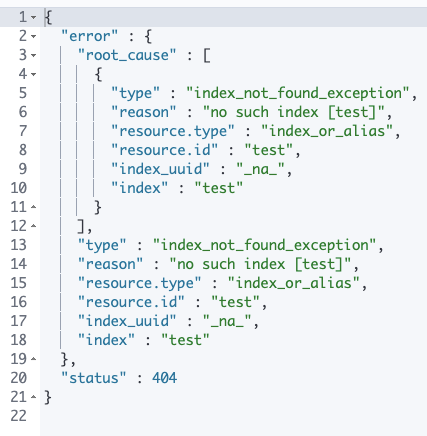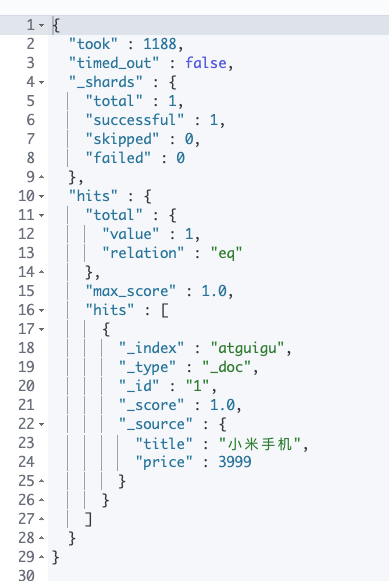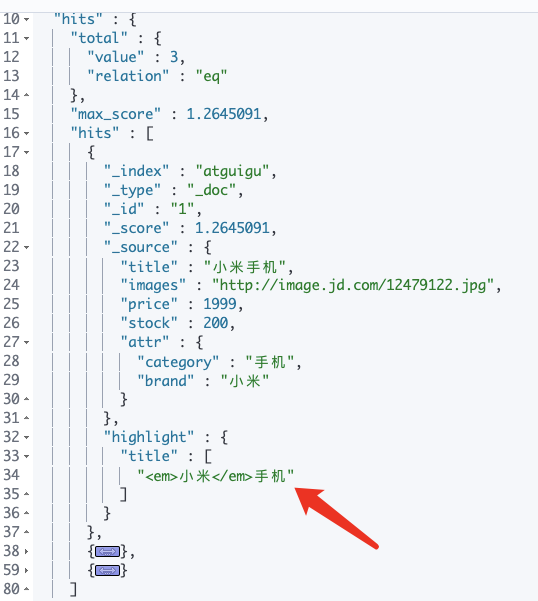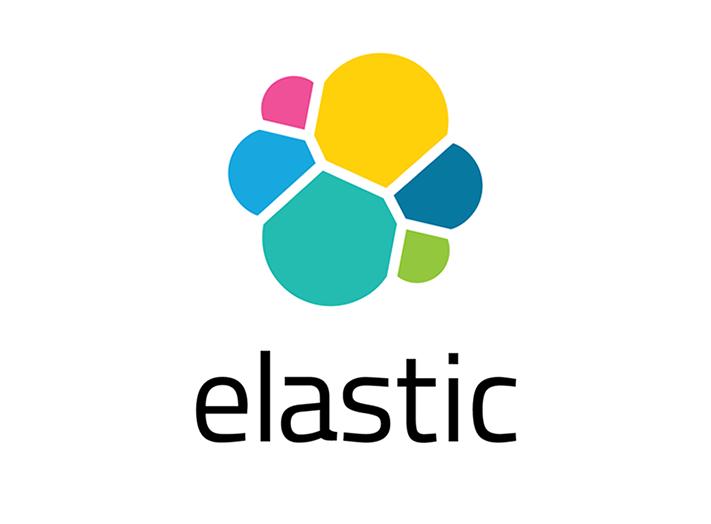1. elasticsearch基本操作
1.1. 基本概念
Elasticsearch也是基于Lucene的全文检索库,本质也是存储数据,很多概念与MySQL类似的。
对比关系:
1
2
3
4
5
6
7
| 索引(indices)----------------------Databases 数据库
类型(type)--------------------------Table 数据表
文档(Document)----------------------Row 行
字段(Field)-------------------------Columns 列
|
要注意的是:Elasticsearch本身就是分布式的,因此即便你只有一个节点,Elasticsearch默认也会对你的数据进行分片和副本操作,当你向集群添加新数据时,数据也会在新加入的节点中进行平衡。
1.2. 索引操作(indeces)
1.2.1. 查询索引
查看es中有哪些索引库:

es 中会默认存在一个名为.kibana和.kibana_task_manager的索引
表头的含义
| 字段名 |
含义说明 |
| health |
green(集群完整) yellow(单点正常、集群不完整) red(单点不正常) |
| status |
是否能使用 |
| index |
索引名 |
| uuid |
索引统一编号 |
| pri |
主节点几个 |
| rep |
从节点几个 |
| docs.count |
文档数 |
| docs.deleted |
文档被删了多少 |
| store.size |
整体占空间大小 |
| pri.store.size |
主节点占 |
1.2.2. 创建索引
参数可选:指定分片及副本,默认分片为3,副本为2。
1
2
3
4
5
6
| {
"settings": {
"number_of_shards": 3,
"number_of_replicas": 2
}
}
|
演示:说明索引创建成功

再次查询,可以看到刚刚创建的索引:

1.2.3. 查看索引具体信息

或者,我们可以使用*来查询所有索引具体信息(已被弃用)
1.2.4. 删除索引
演示:

查看test:

1.3. 映射配置(_mapping)
索引有了,接下来肯定是添加数据。但是,在添加数据之前必须定义映射。
什么是映射?
映射是定义文档的过程,文档包含哪些字段,这些字段是否保存,是否索引,是否分词等
只有配置清楚,Elasticsearch才会帮我们进行索引库的创建(不一定)
1.3.1. 创建映射字段
1
2
3
4
5
6
7
8
9
10
11
12
13
| PUT /索引库名
{
"mappings":{
"properties": {
"字段名": {
"type": "类型",
"index": true,
"store": true,
"analyzer": "分词器"
}
}
}
}
|
类型名称:就是前面将的type的概念,类似于数据库中的不同表
字段名:类似于列名,properties下可以指定许多字段。
每个字段可以有很多属性。例如:
- type:类型,可以是text、long、short、date、integer、object等
- index:是否索引,默认为true
- store:是否存储,默认为false
- analyzer:分词器,这里使用ik分词器:
ik_max_word或者ik_smart
示例
发起请求:
1
2
3
4
5
6
7
8
9
10
11
12
13
14
15
16
17
18
| PUT /atguigu
{
"mappings": {
"properties": {
"title": {
"type": "text",
"analyzer": "ik_max_word"
},
"images": {
"type": "keyword",
"index": "false"
},
"price": {
"type": "long"
}
}
}
}
|
响应结果:
1
2
3
4
| {
"acknowledged": true
}
|
1.3.2. 查看映射关系
语法:
示例:
响应:
1
2
3
4
5
6
7
8
9
10
11
12
13
14
15
16
17
18
19
| {
"atguigu" : {
"mappings" : {
"properties" : {
"images" : {
"type" : "keyword",
"index" : false
},
"price" : {
"type" : "long"
},
"title" : {
"type" : "text",
"analyzer" : "ik_max_word"
}
}
}
}
}
|
type:字段类型。String(text keyword) Numeric(long integer float double) date boolean
index:是否创建索引
analyzer:分词器(ik_max_word)
1.4. 新增文档(document)
有了索引、类型和映射,就可以对文档做增删改查操作了。
1.4.1. 基本玩法
如果我们想要自己新增的时候指定id,可以这么做:
1
2
3
4
| POST /索引库名/_doc/id值
{
...
}
|
演示:
1
2
3
4
5
| POST /atguigu/_doc/1
{
"title": "小米手机",
"price": 3999
}
|
查询得到结果:小米手机的id是我们指定的id

_source:源文档信息,所有的数据都在里面。_id:这条文档的唯一标示,与文档自己的id字段没有关联
1.4.2. 智能判断
事实上Elasticsearch非常智能,你不需要给索引库设置任何mapping映射,它也可以根据你输入的数据来判断类型,动态添加数据映射。
测试一下:
1
2
3
4
5
6
7
8
9
10
11
12
| POST /atguigu/_doc/2 //type已被弃用,同一索引下只有_doc一个type
{
"title":"小米手机",
"images":"http://image.jd.com/12479122.jpg",
"price":2899,
"stock": 200,
"saleable":true,
"attr": {
"category": "手机",
"brand": "小米"
}
}
|
我们额外添加了stock库存,saleable是否上架,attr其他属性几个字段。
来看结果:GET /atguigu/_search
1
2
3
4
5
6
7
8
9
10
11
12
13
14
15
16
17
18
19
20
21
22
23
24
25
26
27
28
29
30
31
32
33
34
35
36
37
38
39
40
41
42
43
44
45
46
| {
"took" : 0,
"timed_out" : false,
"_shards" : {
"total" : 1,
"successful" : 1,
"skipped" : 0,
"failed" : 0
},
"hits" : {
"total" : {
"value" : 2,
"relation" : "eq"
},
"max_score" : 1.0,
"hits" : [
{
"_index" : "atguigu",
"_type" : "_doc",
"_id" : "1",
"_score" : 1.0,
"_source" : {
"title" : "小米手机",
"price" : 3999
}
},
{
"_index" : "atguigu",
"_type" : "_doc",
"_id" : "2",
"_score" : 1.0,
"_source" : {
"title" : "小米手机",
"images" : "http://image.jd.com/12479122.jpg",
"price" : 2899,
"stock" : 200,
"saleable" : true,
"attr" : {
"category" : "手机",
"brand" : "小米"
}
}
}
]
}
}
|
再看下索引库的映射关系: GET /atguigu/_mapping
1
2
3
4
5
6
7
8
9
10
11
12
13
14
15
16
17
18
19
20
21
22
23
24
25
26
27
28
29
30
31
32
33
34
35
36
37
38
39
40
41
42
43
44
45
46
47
| {
"atguigu" : {
"mappings" : {
"properties" : {
"attr" : {
"properties" : {
"brand" : {
"type" : "text",
"fields" : {
"keyword" : {
"type" : "keyword",
"ignore_above" : 256
}
}
},
"category" : {
"type" : "text",
"fields" : {
"keyword" : {
"type" : "keyword",
"ignore_above" : 256
}
}
}
}
},
"images" : {
"type" : "keyword",
"index" : false
},
"price" : {
"type" : "long"
},
"saleable" : {
"type" : "boolean"
},
"stock" : {
"type" : "long"
},
"title" : {
"type" : "text",
"analyzer" : "ik_max_word"
}
}
}
}
}
|
stock,saleable,attr都被成功映射了。
如果是字符串类型的数据,会添加两种类型:text + keyword。如上例中的category 和 brand
1.5. 删除数据
删除使用DELETE请求,同样,需要根据id进行删除:
语法
示例:
结果:
1
2
3
4
5
6
7
8
9
10
11
12
13
14
| {
"_index" : "atguigu",
"_type" : "goods",
"_id" : "3",
"_version" : 2,
"result" : "deleted",
"_shards" : {
"total" : 4,
"successful" : 1,
"failed" : 0
},
"_seq_no" : 1,
"_primary_term" : 1
}
|
2. 查询
之前已经见识了查询功能
查询所有:
根据id查询:
1
| GET /{index}/{type}/{id}
|
除了上述简单查询之外。elasticsearch作为搜索引擎,最复杂最强大的功能就是搜索查询功能。包括:匹配查询、词条查询、模糊查询、组合查询、范围查询、高亮、排序、分页等等查询功能。
基本查询语法如下:
1
2
3
4
5
6
7
8
| GET /索引库名/_search
{
"query":{
"查询类型":{
"查询条件":"查询条件值"
}
}
}
|
这里的query代表一个查询对象,里面可以有不同的查询属性
- 查询类型:
- 例如:
match_all, match,term , range 等等
- 查询条件:查询条件会根据类型的不同,写法也有差异,后面详细讲解
查询结果:
- took:查询花费时间,单位是毫秒
- time_out:是否超时
- _shards:分片信息
- hits:搜索结果总览对象
- total:搜索到的总条数
- max_score:所有结果中文档得分的最高分
- hits:搜索结果的文档对象数组,每个元素是一条搜索到的文档信息
- _index:索引库
- _type:文档类型
- _id:文档id
- _score:文档得分
- _source:文档的源数据
2.1. 数据准备
1
2
3
4
5
6
7
8
9
10
11
12
13
14
15
16
17
18
19
20
21
| POST /atguigu/_bulk
{"index":{"_id":1}}
{ "title":"小米手机", "images":"http://image.jd.com/12479122.jpg", "price":1999, "stock": 200, "attr": { "category": "手机", "brand": "小米" } }
{"index":{"_id":2}}
{"title":"超米手机", "images":"http://image.jd.com/12479122.jpg", "price":2999, "stock": 300, "attr": { "category": "手机", "brand": "小米" } }
{"index":{"_id":3}}
{ "title":"小米电视", "images":"http://image.jd.com/12479122.jpg", "price":3999, "stock": 400, "attr": { "category": "电视", "brand": "小米" } }
{"index":{"_id":4}}
{ "title":"小米笔记本", "images":"http://image.jd.com/12479122.jpg", "price":4999, "stock": 200, "attr": { "category": "笔记本", "brand": "小米" } }
{"index":{"_id":5}}
{ "title":"华为手机", "images":"http://image.jd.com/12479122.jpg", "price":3999, "stock": 400, "attr": { "category": "手机", "brand": "华为" } }
{"index":{"_id":6}}
{ "title":"华为笔记本", "images":"http://image.jd.com/12479122.jpg", "price":5999, "stock": 200, "attr": { "category": "笔记本", "brand": "华为" } }
{"index":{"_id":7}}
{ "title":"荣耀手机", "images":"http://image.jd.com/12479122.jpg", "price":2999, "stock": 300, "attr": { "category": "手机", "brand": "华为" } }
{"index":{"_id":8}}
{ "title":"oppo手机", "images":"http://image.jd.com/12479122.jpg", "price":2799, "stock": 400, "attr": { "category": "手机", "brand": "oppo" } }
{"index":{"_id":9}}
{ "title":"vivo手机", "images":"http://image.jd.com/12479122.jpg", "price":2699, "stock": 300, "attr": { "category": "手机", "brand": "vivo" } }
{"index":{"_id":10}}
{ "title":"华为nova手机", "images":"http://image.jd.com/12479122.jpg", "price":2999, "stock": 300, "attr": { "category": "手机", "brand": "华为" } }
|
2.2. 匹配查询(match)
匹配所有
1
2
3
4
5
6
| GET /atguigu/_search
{
"query":{
"match_all": {}
}
}
|
query:代表查询对象match_all:代表查询所有
条件匹配
1
2
3
4
5
6
7
8
| GET /atguigu/_search
{
"query": {
"match": {
"title": "小米手机"
}
}
}
|
查询出很多数据,不仅包括小米手机,而且与小米或者手机相关的都会查询到,说明多个词之间是or的关系。
某些情况下,我们需要更精确查找,我们希望这个关系变成and,可以这样做:
1
2
3
4
5
6
7
8
9
10
11
| GET /atguigu/_search
{
"query": {
"match": {
"title": {
"query": "小米手机",
"operator": "and"
}
}
}
}
|
查询结果:
1
2
3
4
5
6
7
8
9
10
11
12
13
14
15
16
17
18
19
20
21
22
23
24
25
26
27
28
29
30
31
32
| {
"took" : 26,
"timed_out" : false,
"_shards" : {
"total" : 2,
"successful" : 2,
"skipped" : 0,
"failed" : 0
},
"hits" : {
"total" : 1,
"max_score" : 1.7037868,
"hits" : [
{
"_index" : "atguigu",
"_type" : "goods",
"_id" : "1",
"_score" : 1.7037868,
"_source" : {
"title" : "小米手机",
"images" : "http://image.jd.com/12479122.jpg",
"price" : 1999,
"stock" : 200,
"attr" : {
"category" : "手机",
"brand" : "小米"
}
}
}
]
}
}
|
子属性匹配
1
2
3
4
5
6
7
8
| GET /atguigu/_search
{
"query": {
"match": {
"attr.brand": "小米"
}
}
}
|
多字段匹配
match只能根据一个字段匹配查询,如果要根据多个字段匹配查询可以使用multi_match
1
2
3
4
5
6
7
8
9
| GET /atguigu/_search
{
"query":{
"multi_match": {
"query": "小米",
"fields": ["title", "attr.brand.keyword"]
}
}
}
|
2.3. 词条查询(term)
term 查询被用于精确值 匹配,这些精确值可能是数字、时间、布尔或者那些未分词的字符串。
1
2
3
4
5
6
7
8
| GET /atguigu/_search
{
"query":{
"term":{
"price": 4999
}
}
}
|
2.4. 范围查询(range)
range 查询找出那些落在指定区间内的数字或者时间
1
2
3
4
5
6
7
8
9
10
11
| GET /atguigu/_search
{
"query":{
"range": {
"price": {
"gte": 1000,
"lt": 3000
}
}
}
}
|
range查询允许以下字符:
| 操作符 |
说明 |
| gt |
大于 |
| gte |
大于等于 |
| lt |
小于 |
| lte |
小于等于 |
2.5. 布尔组合(bool)
布尔查询又叫组合查询
bool把各种其它查询通过must(与)、must_not(非)、should(或)的方式进行组合
1
2
3
4
5
6
7
8
9
10
11
12
13
14
15
16
17
18
19
20
21
22
23
24
25
| GET /atguigu/_search
{
"query":{
"bool":{
"must": [
{
"range": {
"price": {
"gte": 1000,
"lte": 3000
}
}
},
{
"range": {
"price": {
"gte": 2000,
"lte": 4000
}
}
}
]
}
}
}
|
注意:一个组合查询里面只能出现一种组合,不能混用
2.6. 过滤(filter)
所有的查询都会影响到文档的评分及排名。如果我们需要在查询结果中进行过滤,并且不希望过滤条件影响评分,那么就不要把过滤条件作为查询条件来用。而是使用filter方式:
1
2
3
4
5
6
7
8
9
10
11
12
13
14
15
| GET /atguigu/_search
{
"query": {
"bool": {
"must": {
"match": { "title": "小米手机" }
},
"filter": {
"range": {
"price": { "gt": 2000, "lt": 3000 }
}
}
}
}
}
|
注意:filter中还可以再次进行bool组合条件过滤。
2.7. 排序(sort)
sort 可以让我们按照不同的字段进行排序,并且通过order指定排序的方式
1
2
3
4
5
6
7
8
9
10
11
12
13
14
15
16
| GET /atguigu/_search
{
"query": {
"match": {
"title": "小米手机"
}
},
"sort": [
{
"price": { "order": "desc" }
},
{
"_score": { "order": "desc"}
}
]
}
|
2.8. 分页(from/size)
1
2
3
4
5
6
7
8
9
10
| GET /atguigu/_search
{
"query": {
"match": {
"title": "小米手机"
}
},
"from": 2,
"size": 2
}
|
from:从那一条开始
size:取多少条
2.9. 高亮(highlight)
高亮的本质是给关键字添加了标签,在前端再给该标签添加样式即可。
1
2
3
4
5
6
7
8
9
10
11
12
13
| GET /atguigu/_search
{
"query": {
"match": {
"title": "小米"
}
},
"highlight": {
"fields": {"title": {}},
"pre_tags": "<em>",
"post_tags": "</em>"
}
}
|
fields:高亮字段
pre_tags:前置标签
post_tags:后置标签
查询结果如下:

2.10. 结果过滤(_source)
默认情况下,elasticsearch在搜索的结果中,会把文档中保存在_source的所有字段都返回。
如果我们只想获取其中的部分字段,可以添加_source的过滤
1
2
3
4
5
6
7
8
9
| GET /atguigu/_search
{
"_source": ["title","price"],
"query": {
"term": {
"price": 2699
}
}
}
|
返回结果,只有两个字段:
1
2
3
4
5
6
7
8
9
10
11
12
13
14
15
16
17
18
19
20
21
22
23
24
25
26
| {
"took" : 9,
"timed_out" : false,
"_shards" : {
"total" : 2,
"successful" : 2,
"skipped" : 0,
"failed" : 0
},
"hits" : {
"total" : 1,
"max_score" : 1.0,
"hits" : [
{
"_index" : "atguigu",
"_type" : "goods",
"_id" : "9",
"_score" : 1.0,
"_source" : {
"price" : 2699,
"title" : "vivo手机"
}
}
]
}
}
|
3. 聚合(aggregations)
聚合可以让我们极其方便的实现对数据的统计、分析。例如:
- 什么品牌的手机最受欢迎?
- 这些手机的平均价格、最高价格、最低价格?
- 这些手机每月的销售情况如何?
实现这些统计功能的比数据库的sql要方便的多,而且查询速度非常快,可以实现实时搜索效果。
3.1 基本概念
Elasticsearch中的聚合,包含多种类型,最常用的两种,一个叫桶,一个叫度量:
桶(bucket)
桶的作用,是按照某种方式对数据进行分组,每一组数据在ES中称为一个桶,例如我们根据国籍对人划分,可以得到中国桶、英国桶,日本桶……或者我们按照年龄段对人进行划分:010,1020,2030,3040等。
Elasticsearch中提供的划分桶的方式有很多:
- Date Histogram Aggregation:根据日期阶梯分组,例如给定阶梯为周,会自动每周分为一组
- Histogram Aggregation:根据数值阶梯分组,与日期类似
- Terms Aggregation:根据词条内容分组,词条内容完全匹配的为一组
- Range Aggregation:数值和日期的范围分组,指定开始和结束,然后按段分组
- ……
bucket aggregations 只负责对数据进行分组,并不进行计算,因此往往bucket中往往会嵌套另一种聚合:metrics aggregations即度量
度量(metrics)
分组完成以后,我们一般会对组中的数据进行聚合运算,例如求平均值、最大、最小、求和等,这些在ES中称为度量
比较常用的一些度量聚合方式:
- Avg Aggregation:求平均值
- Max Aggregation:求最大值
- Min Aggregation:求最小值
- Percentiles Aggregation:求百分比
- Stats Aggregation:同时返回avg、max、min、sum、count等
- Sum Aggregation:求和
- Top hits Aggregation:求前几
- Value Count Aggregation:求总数
- ……
3.2 聚合为桶
首先,我们按照手机的品牌attr.brand.keyword来划分桶
1
2
3
4
5
6
7
8
9
10
11
| GET /atguigu/_search
{
"size" : 0,
"aggs" : {
"brands" : {
"terms" : {
"field" : "attr.brand.keyword"
}
}
}
}
|
- size: 查询条数,这里设置为0,因为我们不关心搜索到的数据,只关心聚合结果,提高效率
- aggs:声明这是一个聚合查询,是aggregations的缩写
结果:
1
2
3
4
5
6
7
8
9
10
11
12
13
14
15
16
17
18
19
20
21
22
23
24
25
26
27
28
29
30
31
32
33
34
35
36
37
38
39
| {
"took" : 124,
"timed_out" : false,
"_shards" : {
"total" : 2,
"successful" : 2,
"skipped" : 0,
"failed" : 0
},
"hits" : {
"total" : 10,
"max_score" : 0.0,
"hits" : [ ]
},
"aggregations" : {
"brands" : {
"doc_count_error_upper_bound" : 0,
"sum_other_doc_count" : 0,
"buckets" : [
{
"key" : "华为",
"doc_count" : 4
},
{
"key" : "小米",
"doc_count" : 4
},
{
"key" : "oppo",
"doc_count" : 1
},
{
"key" : "vivo",
"doc_count" : 1
}
]
}
}
}
|
- hits:查询结果为空,因为我们设置了size为0
- aggregations:聚合的结果
- brands:我们定义的聚合名称
- buckets:查找到的桶,每个不同的品牌字段值都会形成一个桶
- key:这个桶对应的品牌字段的值
- doc_count:这个桶中的文档数量
3.3 桶内度量
前面的例子告诉我们每个桶里面的文档数量,这很有用。 但通常,我们的应用需要提供更复杂的文档度量。 例如,每种品牌手机的平均价格是多少?
因此,我们需要告诉Elasticsearch使用哪个字段,使用何种度量方式进行运算,这些信息要嵌套在桶内,度量的运算会基于桶内的文档进行
现在,我们为刚刚的聚合结果添加 求价格平均值的度量:
1
2
3
4
5
6
7
8
9
10
11
12
13
14
15
16
17
18
| GET /atguigu/_search
{
"size" : 0,
"aggs" : {
"brands" : {
"terms" : {
"field" : "attr.brand.keyword"
},
"aggs":{
"avg_price": {
"avg": {
"field": "price"
}
}
}
}
}
}
|
- aggs:我们在上一个aggs(brands)中添加新的aggs。可见
度量也是一个聚合
- avg_price:聚合的名称
- avg:度量的类型,这里是求平均值
- field:度量运算的字段
结果:
1
2
3
4
5
6
7
8
9
10
11
12
13
14
15
16
17
18
19
20
21
22
23
24
25
26
27
28
29
30
31
32
33
34
35
36
37
38
39
40
41
42
43
44
45
46
47
48
49
50
51
52
| {
"took" : 41,
"timed_out" : false,
"_shards" : {
"total" : 2,
"successful" : 2,
"skipped" : 0,
"failed" : 0
},
"hits" : {
"total" : 10,
"max_score" : 0.0,
"hits" : [ ]
},
"aggregations" : {
"brands" : {
"doc_count_error_upper_bound" : 0,
"sum_other_doc_count" : 0,
"buckets" : [
{
"key" : "华为",
"doc_count" : 4,
"avg_price" : {
"value" : 3999.0
}
},
{
"key" : "小米",
"doc_count" : 4,
"avg_price" : {
"value" : 3499.0
}
},
{
"key" : "oppo",
"doc_count" : 1,
"avg_price" : {
"value" : 2799.0
}
},
{
"key" : "vivo",
"doc_count" : 1,
"avg_price" : {
"value" : 2699.0
}
}
]
}
}
}
|
可以看到每个桶中都有自己的avg_price字段,这是度量聚合的结果
3.4 桶内嵌套桶
刚刚的案例中,我们在桶内嵌套度量运算。事实上桶不仅可以嵌套运算, 还可以再嵌套其它桶。也就是说在每个分组中,再分更多组。
比如:我们想统计每个品牌都生产了那些产品,按照attr.category.keyword字段再进行分桶
1
2
3
4
5
6
7
8
9
10
11
12
13
14
15
16
17
18
19
20
21
22
23
| GET /atguigu/_search
{
"size" : 0,
"aggs" : {
"brands" : {
"terms" : {
"field" : "attr.brand.keyword"
},
"aggs":{
"avg_price": {
"avg": {
"field": "price"
}
},
"categorys": {
"terms": {
"field": "attr.category.keyword"
}
}
}
}
}
}
|
部分结果:
1
2
3
4
5
6
7
8
9
10
11
12
13
14
15
16
17
18
19
20
21
22
23
24
25
26
27
28
29
30
31
32
33
34
35
36
37
38
39
40
41
42
43
44
45
46
47
48
49
50
51
52
53
54
55
56
57
58
59
60
61
62
63
64
65
66
67
68
69
70
71
72
73
74
75
76
77
78
79
80
81
82
83
84
85
86
87
88
89
90
91
92
93
94
95
96
97
98
99
100
101
102
103
104
| {
"took" : 19,
"timed_out" : false,
"_shards" : {
"total" : 2,
"successful" : 2,
"skipped" : 0,
"failed" : 0
},
"hits" : {
"total" : 10,
"max_score" : 0.0,
"hits" : [ ]
},
"aggregations" : {
"brands" : {
"doc_count_error_upper_bound" : 0,
"sum_other_doc_count" : 0,
"buckets" : [
{
"key" : "华为",
"doc_count" : 4,
"categorys" : {
"doc_count_error_upper_bound" : 0,
"sum_other_doc_count" : 0,
"buckets" : [
{
"key" : "手机",
"doc_count" : 3
},
{
"key" : "笔记本",
"doc_count" : 1
}
]
},
"avg_price" : {
"value" : 3999.0
}
},
{
"key" : "小米",
"doc_count" : 4,
"categorys" : {
"doc_count_error_upper_bound" : 0,
"sum_other_doc_count" : 0,
"buckets" : [
{
"key" : "手机",
"doc_count" : 2
},
{
"key" : "电视",
"doc_count" : 1
},
{
"key" : "笔记本",
"doc_count" : 1
}
]
},
"avg_price" : {
"value" : 3499.0
}
},
{
"key" : "oppo",
"doc_count" : 1,
"categorys" : {
"doc_count_error_upper_bound" : 0,
"sum_other_doc_count" : 0,
"buckets" : [
{
"key" : "手机",
"doc_count" : 1
}
]
},
"avg_price" : {
"value" : 2799.0
}
},
{
"key" : "vivo",
"doc_count" : 1,
"categorys" : {
"doc_count_error_upper_bound" : 0,
"sum_other_doc_count" : 0,
"buckets" : [
{
"key" : "手机",
"doc_count" : 1
}
]
},
"avg_price" : {
"value" : 2699.0
}
}
]
}
}
}
|
- 我们可以看到,新的聚合
categorys被嵌套在原来每一个brands的桶中。
- 每个品牌下面都根据
attr.category.keyword字段进行了分组
- 我们能读取到的信息:
- 华为有4中产品
- 华为产品的平均售价是 3999.0美元。
- 其中3种手机产品,1种笔记本产品









